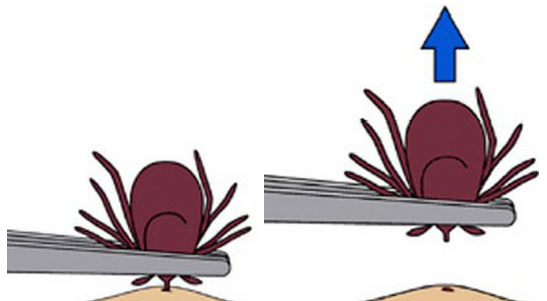Table of Contents

Warm weather means many of us are getting out and enjoying the great outdoors. The warm weather also brings out ticks, small bugs that bite and feed on the blood of humans and animals and can sometimes transmit disease.
Ticks are most often found in tall grass and wooded areas. Fortunately, there are precautions people can take to prevent illnesses that may be transmitted from tick bites.

What You Need to Know About Lyme Disease
Most (about 98%) Lyme disease cases are associated with the bite of the nymphal stage of the blacklegged tick, of which 10-36% may be infected with Lyme disease spirochetes.
Nymphal blacklegged ticks are very small (about the size of a pinhead), difficult to spot, and are active during the late spring and summer months when human outdoor activity is greatest. The majority (about 75%) of Lyme disease cases are associated with activities (play, yard or garden work) around the home.
Adult blacklegged ticks are active in the fall, warmer days in the winter, and in the spring when outdoor activity and exposure is more limited. They are larger, easier to spot, and therefore associated with fewer cases of Lyme disease (even though infection rates are higher).

Natural Tick Repellents
Although tick repellents and pesticides for use on skin, clothing, or in the yard are considered safe and effective when used as directed, many people are reluctant to use them. In order to provide other options, scientists have been developing all-natural chemical compounds made from plants that can repel or kill ticks.
Below is the list of some natural products that can be used on your skin or yard and lawn to repel ticks:
- Essential oil from leaves and stems of the wild tomato plant, Lycopersicon hirsutum.
- Essential oil from garlic plants.
- Essential oils from rosemary, lemongrass, thyme, and geraniol plants.
- Essential oils from Alaska yellow cedar trees, some herbs, and citrus fruits.
- Fungus, Metarhizium brunneum/anisopliae.

Routing Skin Checks for Ticks
Do not neglect the most important ways to reduce the risk of tick illnesses is to do a skin check on yourself, your children, and your pets after being outdoors. Other precautions include:
- Walking on cleared trails when in tall grass or wooded areas.
- Wearing a hat, long sleeves, pants, and light-coloured clothing.
- Tucking pant legs into socks or boots.
- Applying insect repellent containing DEET on uncovered skin.
- Carefully checking clothing and scalp (covered or not) when leaving an area where ticks may live.

Preventing Ticks In The Yard
To keep those nasty ticks from entering your home and yard, try these steps:
- Keep your lawn short and remove any fallen leaves and weeds.
- Keep a buffer area such as wood-chip or gravel border between your lawn and wooded areas or stone walls. Any play equipment or play zones should be kept away from wooded areas.
- Trim tree branches to allow more sunlight in your yard.
- Keep wood piles and bird feeders away from the house.
- Widen and maintain trails on your property.
How To Remove A Tick
If you find a tick on yourself, a family member, or pet, wear gloves and gently remove it. Be careful not to crush the tick as this could cause it to inject its stomach contents into your skin. If you find a tick, check very carefully for others. Other tips to remove ticks safely include:
- Use needle-nose tweezers to gently grasp the tick close to the skin.
- Without squeezing, pull the tick straight out.
- After removal, clean the area with soap and water.

Preventive measures are often considered inconvenient and, in the summer, uncomfortable. Despite the efficiency of tick repellents, particularly with DEET applied to skin and permethrin applied to clothing, they are under-utilized.Personal protection behaviors, including avoidance and reduction of time spent in tick-infested habitats, using protective clothing and tick repellents, checking the entire body for ticks, and promptly removing attached ticks can be very effective methods for the prevention of tick associated disease.





